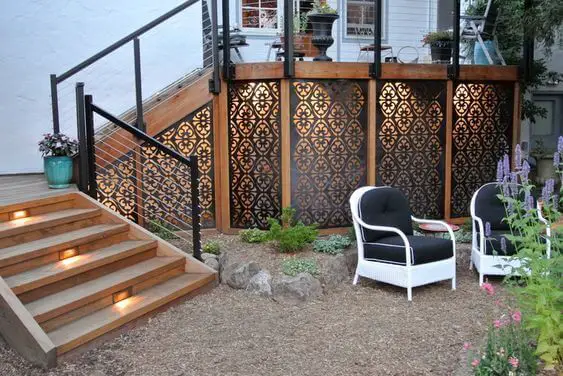Your ceiling is ugly. Or, perhaps your ceiling isn’t ugly, but it is dreadfully boring. In the age of maximalism, you want to decorate every inch of your home, and that means your ceilings are in desperate need of an upgrade. Fortunately, there are several ways to change the look of your ceilings — and unfortunately, not all of them are easy. Here’s a quick list of your ceiling improvement options, from most doable to most difficult.
Paint
Conventional wisdom suggests that keeping your ceilings white helps to maximize natural light and lend your home a sense of comfortable airiness. However, there are plenty of reasons you might want to throw conventional wisdom out the window. Ceilings painted in a dark color can enhance the coziness and mystery of a space, especially one that is already small and dark to begin with. Ceilings painted the same color as your walls can provide an illusion that your walls are taller than they actually are. Most importantly, painted ceilings are different from what most people are used to. The only thing you need to do to paint you ceiling is protect your floor, furniture and décor from paint drips — and stretch out your neck and shoulders afterwards.
Wallpaper
Wallpaper is in, in a big way, thanks in no small part to peel-and-stick, which makes wallpaper dramatically easier to apply and replace. Wallpaper works best in smaller spaces that do not have much wall space for decoration — like kitchens, laundry rooms and powder rooms — as the wallpaper will ornament the area with color and pattern without overwhelming the eye. It is important to note that brighter colors and busier patterns can affect perception of the space, making the room feel smaller, so you may want to opt for simpler wallpaper if you do cover your ceiling in a main area of your home. For this project, you should also strive to find a peel-and-stick option, as you are likely to make a few mistakes as you get the hang of hanging wallpaper on your ceiling.
Fabric Drapery
One of the more dramatic and less common ceiling decorations, fabric drapery can make a room feel sumptuous. Usually draped from the center of a room, fabric helps to soften the hard edges of a space; it also dampens sound and holds in heat to create an intimate environment. Achieving an attractive drapery effect will require several yards of fabric, and there are specialized ceiling mounts for fabric drapery. Getting the fabric to hang correctly could take some fussing, but this solution is relatively quick and painless — and works great if you are a renter looking to cover up a stained or popcorn ceiling.
Medallion
A medallion is usually an architectural element that surrounds fixtures hung from your ceiling, like ceiling fans or lights. Traditionally, medallions are sculpted plaster, but you can find premade wood and foam medallions at your local home improvement store. You can affix one of these moldings to your ceiling using finishing nails. Alternatively, you can DIY your own ceiling medallion using any material you prefer — to include paint alone. Medallions look best in homes that already have quite a bit of millwork and molding, but with some creativity, they can look dazzling in any space.
Ceiling Tiles
In truth, “ceiling tiles” is a category of ceiling decoration that encompasses a wide variety of solutions. You might initially imagine the ugly asbestos tiles used in drop ceilings in commercial buildings, but there are many other stunning ceiling tile options for you to consider. Tin tiles are coming back into fashion, which utilize an adhesive compound to stick thin, ornate tin or copper tiles to the ceiling. Similar systems are used for non-metal tiles, which can take the form of basic ceiling moldings. Often, non-metal decorative ceiling tiles are made from foam, but because they are hung out of reach, they are unlikely to experience damage after installation.
Wood Beams
Homes with wood beams tend to be brimming with character — which is why so many homeowners have opted to fake the feature in their own homes. You can find premade wood beams made of wood or foam which attach to your ceiling’s existing joists through the drywall via screws or nails. Of course, if you want your home’s real wood beams peaking through your ceiling, you will need to embark on a much more intensive project of raising your ceiling above the level of your joists. Generally, wood beams are not a good choice for homes with ceilings lower than 12 feet, as the beams will take up too much headroom and visual space for comfort.
Molding
By far the most difficult but easily the most impressive way to add style to your ceiling is to install moldings. The most popular types of ceiling moldings are crown moldings, which add ornamentation to the crack between your upper walls and ceiling. However, you might also consider installing coffers, which are moldings that transform the ceiling into a sunken grid, or paneling, like tongue-in-groove or shiplap, both of which can add more texture to the vast expanse of your ceiling. Applying molding is difficult, requiring exact measurements and cuts, and it tends to look best in homes with taller ceilings and wall millwork, like wainscoting.
You don’t have to live with an ugly ceiling forever. With the right project, you can transform your ceiling into a prized feature of your home — but before you start, you should perform plenty of research to ensure you know what you are doing.




